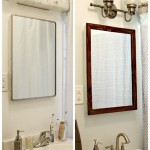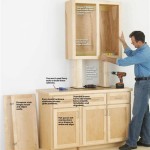Staining Kitchen Cabinets Without Sanding Or Priming Them
Restaining kitchen cabinets can significantly alter the appearance of a kitchen, providing a fresh and updated aesthetic without the extensive cost of total cabinet replacement. While traditional methods often involve thorough sanding and priming as crucial steps, techniques exist that allow for restaining cabinets without these time-consuming processes. These methods rely on specialized cleaning and bonding agents that prepare the existing surface for the new stain, ensuring proper adhesion and a durable finish.
The feasibility of staining cabinets without sanding or priming hinges on the existing finish's condition and type. Cabinets with intact, non-glossy finishes are generally more amenable to this approach. Heavily damaged or peeling finishes necessitate more comprehensive preparation, which may include some degree of sanding. Similarly, cabinets finished with varnish or polyurethane require specialized cleaning and bonding to ensure the new stain adheres properly. The goal is to create a surface that is clean, slightly porous, and chemically receptive to the new stain.
This article will explore a step-by-step process for staining kitchen cabinets without sanding or priming, focusing on the necessary materials, preparation techniques, application methods, and considerations for achieving a professional-looking result. The key is meticulous surface preparation combined with the use of products specifically designed for bonding to existing finishes.
Key Point 1: Thorough Cleaning and Degreasing
The crucial first step in staining kitchen cabinets without sanding or priming lies in rigorously cleaning and degreasing the surfaces. Years of accumulated grease, grime, and airborne cooking residues can create a barrier that prevents the new stain from properly bonding to the existing finish. Skipping this critical step will likely result in an uneven stain application and premature peeling or flaking of the finish.
The recommended cleaning agent is often a trisodium phosphate (TSP) cleaner, diluted according to the manufacturer's instructions. TSP is a powerful degreaser that effectively removes stubborn grime and prepares the surface for subsequent treatments. However, TSP can be harsh and should be handled with caution, wearing gloves and eye protection. Alternatives to TSP include phosphate-free cleaners specifically designed for removing grease and wax from wood surfaces. These alternatives are generally safer and more environmentally friendly.
The cleaning process involves applying the chosen cleaning solution to the cabinet surfaces using a sponge or microfiber cloth. It is essential to work in sections, ensuring that all areas are thoroughly saturated with the cleaner. Allow the cleaner to dwell on the surface for the recommended time, typically a few minutes, to loosen the accumulated grime. Then, using a clean, damp cloth, rinse the surfaces thoroughly to remove all traces of the cleaning solution.
For cabinets with particularly heavy grease buildup, multiple cleaning passes may be necessary. A scrub brush with soft bristles can be used to agitate the surface and dislodge stubborn grime. Pay close attention to corners, edges, and areas around handles and knobs, as these areas tend to accumulate the most grime. After the final rinse, allow the cabinets to dry completely before proceeding to the next step.
In addition to cleaning, consider removing hardware such as knobs, pulls, and hinges. This allows for easier access to all cabinet surfaces and prevents stain from accidentally getting on the hardware. Label each piece of hardware and its corresponding location to ensure easy reinstallation after the staining process is complete. Filling any existing hardware holes with wood filler will enable the installation of new or differently positioned hardware for a more updated look.
Key Point 2: Application of a Liquid Deglosser/Bonding Agent
Once the cabinets are thoroughly cleaned and dried, the next step involves applying a liquid deglosser/bonding agent. This product serves two critical functions: it dulls the existing glossy finish, creating a slightly porous surface for better stain adhesion, and it provides a chemical bond between the old finish and the new stain.
Liquid deglossers are typically available as a liquid or gel. They work by chemically etching the surface, creating microscopic grooves that allow the stain to grip the existing finish. Some products combine the deglossing and bonding functions into a single application. It is essential to select a product specifically designed for the type of finish on the cabinets. For example, some deglossers are formulated for use on polyurethane or varnish finishes, while others are designed for painted surfaces.
The application process for liquid deglossers typically involves applying the product to the surface using a clean cloth or applicator pad. It is important to follow the manufacturer's instructions closely, as the application technique and dwell time can vary depending on the product. In general, the deglosser should be applied evenly, ensuring that all areas are thoroughly covered. Avoid pooling or dripping, which can lead to an uneven finish.
After applying the deglosser, allow it to dwell on the surface for the recommended time. This allows the product to chemically etch the finish and create the necessary surface texture for stain adhesion. The dwell time can range from a few minutes to several hours, depending on the product and the existing finish. Once the dwell time has elapsed, wipe off any excess deglosser with a clean cloth. Some products require no wiping, as they are designed to evaporate and leave behind a bonding residue.
Before proceeding to the staining step, it is essential to allow the deglosser to dry completely. This may take several hours, depending on the product and the ambient humidity. Touching the surface to ensure that it is no longer tacky or sticky is advisable. Applying stain to a wet or damp surface can compromise adhesion and result in an uneven finish.
Key Point 3: Application of the Stain and Sealer
After the deglosser has fully dried, the final step involves applying the stain and sealer. Selecting the right type of stain is crucial for achieving the desired aesthetic and ensuring long-term durability. Gel stains are often recommended for staining cabinets without sanding, as their thick consistency allows them to adhere well to non-porous surfaces and provide even coverage.
Before applying the stain, it is essential to test it in an inconspicuous area, such as the inside of a cabinet door, to ensure that the color and finish are satisfactory. This also allows for experimenting with different application techniques to achieve the desired look. Stir the stain thoroughly before use to ensure that the pigments are evenly dispersed.
The stain can be applied using a brush, cloth, or foam applicator. Applying the stain in thin, even coats is recommended, working in the direction of the wood grain. Avoid applying too much stain at once, as this can lead to drips and uneven coverage. After applying the stain, wipe off any excess with a clean cloth. This helps to even out the color and prevent the stain from becoming too dark.
The number of stain coats required depends on the desired color intensity. For a lighter stain, one coat may be sufficient. For a darker stain, multiple coats may be necessary. Allow each coat of stain to dry completely before applying the next. The drying time can vary depending on the type of stain and the ambient humidity.
Once the stain has dried completely, apply a clear sealant or topcoat to protect the finish and enhance its durability. Polyurethane is a popular choice for cabinet sealers, as it provides a tough, water-resistant finish. Apply the sealant in thin, even coats, following the manufacturer's instructions. Allow each coat of sealant to dry completely before applying the next. Two to three coats of sealant are typically recommended for optimal protection.
Lightly sanding between coats of sealant with fine-grit sandpaper can help to create a smoother finish. Be sure to wipe away any sanding dust before applying the next coat of sealant. Once the final coat of sealant has dried completely, reattach the hardware and reinstall the cabinet doors. Allow the finish to cure completely before using the cabinets. The curing time can vary depending on the type of sealant and the ambient humidity. Typically, a curing time of several days to a week is recommended.
Maintaining the newly stained cabinets involves regular cleaning with a mild soap and water solution. Avoid using harsh chemicals or abrasive cleaners, as these can damage the finish. Periodically applying a furniture polish or wax can help to protect the finish and keep the cabinets looking their best.
While staining cabinets without sanding or priming can be a cost-effective and time-saving alternative to traditional methods, it is essential to understand the limitations of this approach. This method is best suited for cabinets with intact, non-glossy finishes. Heavily damaged or peeling finishes may require more comprehensive preparation, including sanding and priming. Additionally, the long-term durability of the finish may not be as robust as with traditional methods. However, with proper preparation and application, staining cabinets without sanding or priming can provide a beautiful and durable finish that will update the look of your kitchen for years to come.

How To Paint Kitchen Cabinets Without Sanding Or Priming

How To Paint Laminate Cabinets Without Sanding The Palette Muse

Painting Over Oak Cabinets Without Sanding Or Priming Hometalk

How To Paint Kitchen Cabinets Without Sanding Or Priming

Prep And Paint Cabinets Without Sanding

How To Paint Cabinets Without Removing Doors House Mix

How To Paint Your Cabinets In A Weekend Without Sanding Them Chris Loves Julia

Prep And Paint Cabinets Without Sanding

How To Paint Kitchen Cabinets Without Sanding Or Priming

Paint Kitchen Cabinets Without Sanding Six Simple Steps
Related Posts








